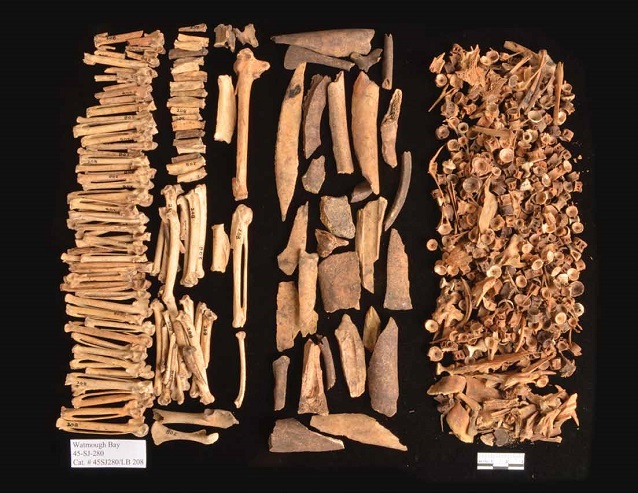
Photograph courtesy of Burke Museum of Natural History and Culture
Abstract
Archaeofaunal remains provide a unique record of how ecological systems have varied through time. Despite the fact that archaeologists in Alaska have been ac-cumulating data for over 100 years, these data have never been compiled into a comprehensive database. While it is likely that human populations were not evenly distributed across the landscape, coverage of archaeological survey efforts are also not evenly distributed. Likewise, analysis effort has not been evenly distributed. Documenting the uneven distribution of sampling is an important first step to utilizing archaeofaunal data to their full potential.
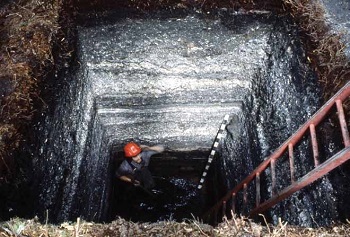
Photograph courtesy of Roy Carlson, Simon Fraser University
Introduction
Archaeofaunal remains—preserved bones and shells from archaeological and paleontological sites (Figure 1)—provide important, but under-utilized, repositories of unique natural and cultural resource data spanning several millennia (Figure 2). These remains have the potential to add significantly to our understanding of the effects of past climate change at an ecosystem level. By extension, these data can provide a measure of the degree of ecological changes likely to be experienced in the future under various climate change scenarios.
Archaeologists have been excavating and reporting on their work in Alaska for over 100 years (Dall 1877, Jochelson 1925, Veltre and Smith 2010), amassing data from tens of thousands of sites statewide. However, the archaeofaunal data from these sites have never been compiled into a single, comprehensive database. Ultimately, we will be compiling these data into a web-accessible paleoecological database called Neotoma. Neotoma already archives vertebrate paleontological and archaeological data from the contiguous United States. Until this has been accomplished for data from Alaska, this important source of information will continue to be under-utilized.
Here, we report on one aspect of our on-going efforts to compile archaeofaunal data from Southwest Alaska. Specifically, we present data on the number of archaeological sites for which archaeofaunal data are available relative to the total number of identified sites. Despite over 100 years of active research in the area, large data gaps still exist.
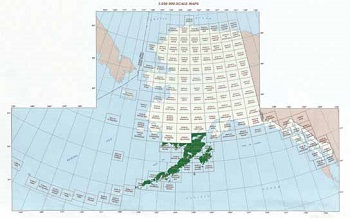
Methods
We have been systematically accumulating taxonomic identification data from sites in Southwest Alaska from published and unpublished sources. This has been accomplished through literature reviews, personal knowledge of gray literature reports, and solicitations for information from members of the Alaska Consortium of Zooarchaeologists.
In addition, we queried the Alaska Office of History and Archaeology database of recorded archaeological sites, known as the Alaska Heritage Resources Survey (AHRS), for each of the 20 U.S. Geological Survey 1:250,000 quadrangle maps located within Southwest Alaska (Figure 3). First, we queried the AHRS database for a complete list of archaeological sites in each quadrangle. Because we are interested in compiling all known archaeofaunal data, no distinction was made between prehistoric and historic sites. Second, the AHRS database was queried for the list of sites in those quadrangles with any of the following terms in the catalog record: midden, bone, shell, or fauna. Site records were reviewed to eliminate instances where those search terms were negated (e.g., “no faunal remains found at this site”). Sites where human remains were the only bones observed were also eliminated from our list.
Finally, we checked our AHRS search results against the list of sites for which we have obtained taxonomic identification data, adding those cases for which identifi-cation data exist but did not appear in our AHRS queries.
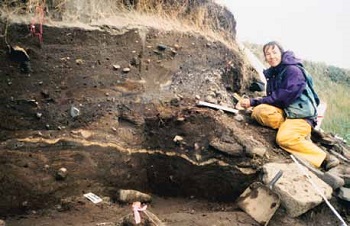
Photograph courtesy of Mike Etnier
Results
The AHRS site catalog includes 3,867 unique entries of archaeological sites in Southwest Alaska. The number of sites recorded in any given quadrangle ranges from two (Bristol Bay, XBB) to 1124 (Kodiak, KOD) (Figure 6). The number of sites reported to have preserved faunas ranges from zero (Stepovak Bay, XSB) to 330 (KOD). The number of archaeofaunal collections for which taxonomic identification data have been located is 57.
As with the summary statistics for quadrangles, the spatial distribution of archaeological sites reported to have preserved faunal remains is also distinctly uneven (Figure 7), with the Kodiak Archipelago and portions of the Katmai Coast having disproportionately high numbers of sites with faunal remains.This is likely due to a combination of factors, which will be discussed below.
Likewise, the distribution of sites with available taxonomic information also appears to be unevenly distributed. Within the XMK quadrangle, the quadrangle for which we have the most complete data, 42 of the 229 recorded sites are reported to have faunal remains. Fifteen of those 42 have available taxonomic identification data—one of the highest percentages (36%) of any of the quadrangles in our study area. However, the bulk of the sites with available taxonomic information (10) lie within a single embayment (Kukak Bay), with decreasing percent-ages in each of several other areas within XMK (Figure 8).

Photograph courtesy of Mike Etnier
Discussion and Conclusions
Our research into this topic is on-going, and these results should only be considered preliminary. However, while the overall numbers are expected to change somewhat, we expect the general patterns to remain the same. Specifically, it is clear from a number of different studies that the Kodiak Archipelago was one of the most densely populated areas in all of Alaska (Crowell et al. 2001, 2003; cf. Steffian and Saltonstall 2008). When coupled with the specific nature of the archaeological record—shell-bearing middens with excellent preservation—it should come as no surprise that this area also contains the highest number of archaeological sites reported to have preserved faunas.
What is perhaps surprising is the relatively low percentage of those preserved faunal samples that have been analyzed. When the data are combined for the quadrangles that comprise the Kodiak Archi-pelago—Afognak, Karluk, Kodiak, Trinity Island, and Kaguyak—only 21 sites have been analyzed out of a field of 560 sites with preserved faunas (3.8%, see Figure 6).
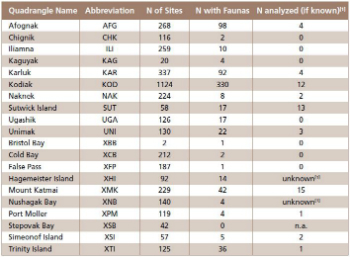
[1] We have not yet compiled faunal data for the Hagemeister Island and Nushagak Bay quadrangles.
One potentially biasing factor in the analysis of the summary statistics for sites from the Kodiak Archipelago is that the term “midden” is used much more generally by researchers in that area to refer to any anthropogenic sediment deposit, regardless of whether or not faunal remains are preserved. Based on the site records on file with the AHRS, 160 sites have been tentatively included in our list despite the ambiguity of the use of the term “mid-den” in the catalog. In a worst-case scenario where all 160 of those sites were removed from our list, the percentage of analyzed sites would increase to 5.3% (21/400).
Finally, it should be pointed out that an accurate comparison of the gross number of sites in any given quadrangle should account for miles of coastline, survey effort, and geological/tectonic histories (e.g., Crowell and Mann 1996, VanderHoek and Myron 2004). Likewise, the current analysis accords equal weight to all analyzed archaeofaunal samples, regardless of sample size. Thus, while it may at first glance appear that Kukak Bay, for instance, has been very well-studied, those analyses are, in fact, based on relatively small samples of archaeofaunas. These factors will be addressed in future analyses.
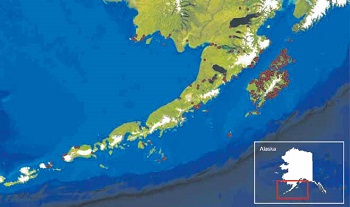
Cartography by Davina Miller, Western Washington University
Management Implications
We acknowledge that this study does not yet address climate change, per se. Those analyses will come after uploading the compiled data to the Neotoma paleo-ecological database, which includes several analytical tools. However, any analysis of changing distributions of vertebrate and invertebrate taxa must be based on a solid sampling strategy. Therefore, analyses such as those presented here are an important first step to evaluating the sufficiency of the available data. Future steps include normalizing our counts of sites-per-quadrangle for field effort and extent of shoreline. Once this is accomplished, these data can be used to help identify areas that need more archaeological survey effort, recovery effort, and taxonomic identification effort.
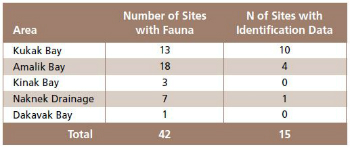
Acknowledgements
This research was funded by the NPS Cultural Resource Preservation Program through a Cooperative Agreement with the Pacific Northwest Cooperative Ecosystem Studies Unit to Western Washington University. Access to the AHRS database was granted by the Alaska Office of History and Archaeology. Staff at the Alutiiq Museum have been particularly helpful in cross-referencing site data in the AHRS database.
References
Crowell, A.L., and D.H. Mann. 1996. Sea level dynamics, glaciers, and archaeology along the central gulf coast of Alaska. Arctic Anthropology 33: 16-37.
Crowell, A.L., M. Matson, and D.H. Mann. 2003. Subsistence Resources and Archaeological Settlement Patterns on the Katmai Coast. Alaska Journal of Anthropology 1(2): .
Crowell, A.L., A.F. Steffian, and G. Pullar (eds). 2001. Looking Both Ways: Heritage and Identity of the Alutiiq People. University of Alaska Press. Fairbanks, Alaska.
Dall, W.H. 1877. On succession in the shell-heaps of the Aleutian
Islands. In Tribes of the Extreme Northwest. Contributions to North American Ethnology 1, edited by D.H. Dall, pp. 41-91. U.S. Government Printing Office. Washington, D.C.
Jochelson, W. 1925. Archaeological Investigations in the Aleutian Islands. Washington. Carnegie Institution.
Steffian, Amy F., and Patrick G. Saltonstall. 2008. Kodiak Archipelago, Southcentral Alaska. In Archaeology in America, An Encyclopedia, edited by Francis P. McManamon and Thalia Gray. Greenwood Publishing Group. Westport, CT.
VanderHoek, Richard, and Rachel Myron. 2004. Cultural Remains from a Catastrophic Landscape: An Archaeological Overview and Assessment of Aniakchack National Monument and Preserve. National Park Service, Alaska Office. Anchorage, Alaska.
Veltre, D.W., and M.A. Smith. 2010. Historical Overview of Archaeological Research in the Aleut Region of Alaska. Human Biology 82: 487-506.
Part of a series of articles titled Alaska Park Science - Volume 11 Issue 2: Science in Southwest Alaska.
Last updated: October 12, 2022
